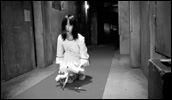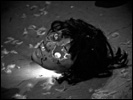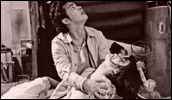Shock Labyrinth 3D
- Year
- 2009
- Original title
- Senritsu Meikyu 3D
- Japanese title
- 戦慄迷宮3D
- Director
- Cast
- Running time
- 93 minutes
- Published
- 14 March 2011



by Jasper Sharp
3D is back and currently all the rage within the film industry. You hardly need me to tell you that here... except that as our multiplexes remained crammed with all the latest stereoscopic baubles throughout 2010 - Tron, Shrek Forever After, The Last Airbender, Despicable Me, etc. - you might have wondered how industries outside of Hollywood were reacting to the renewed craze.
There are many out there who dismiss this recent revival of 3D out of hand. They claim that if the periodic reintroductions of the stereoscopic format, first exploited commercially as far back as the release of Arch Oboler's Bwana Devil in 1952, were anything more than gimmicks to attract the jaded consumer back into the auditorium, then the medium would have become standard long ago. This ignores several crucial points, for example, that the technology used during this initial short blip in the early 1950s was unreliable and expensive to operate, requiring specialist screens and projectors - two of them, in fact, each screening separate prints that needed to be kept perfectly synchronised for the effect to work painlessly, and hence often the need for two projectionists (both of whom needed paying a separate wage). Stereoscopic 3D was also superseded by another technological watershed that similarly appealed to the paying public's desire for novelty and spectacle: notably the introduction of the widescreen CinemaScope format by 20th Century Fox not long after with the release of The Robe in 1953, with other rival formats such as VistaVision and Todd-AO soon to follow.
No such snags with the technology in today's digital era, and not so much sign of consumer resistance either, if the sheer volume of such releases from the past year is taken into account - just critical resistance, although one feels that the naysayers are often motivated by a certain snobbishness, as thus far the medium has mainly been embraced primarily by fairly lowbrow genres. If you've ever taken a look at my posts about 3D on my blog, however, you'll know that I for one am intrigued by how this new technology is going to shape our viewing experiences over the coming years. Its previous revivals have never really lasted long enough for filmmakers to fully explore any 3D aesthetic beyond thrusting various objects out of the screen at the viewer. Now that a substantial body of work has accumulated for us to analyse, it's evident that some degree of stylistic evolution is in process, and just where Japanese filmmakers sit within this is clearly worthy of further consideration.
It is for these reasons that I found Shock Labyrinth, the latest genre workout from Takashi Shimizu, the director of Ju-On: The Grudge, a more painless experience than, say, the majority of IMDB users who, at the time of writing, have collectively awarded the film a measly 3.9/10. It's really not that bad. Let's face it, you don't go to Shimizu if you want compelling storytelling, rich and complex characterisation, and someone who's going to push the J-horror genre to a whole new level. The only real purpose of this particular title, in which a group of four teenagers find themselves returned to the very same 'Shock Labyrinth' amusement park attraction where one of them went missing as a child, seems to be to pimp to a global audience the joys of the Labyrinth of Horrors (also known as the Haunted Hospital) at Fuji-Q Highland theme park in Fujiyoshida, which currently holds the record for the world's largest walk-through haunted house (an accolade it snatched from Erebus in Pontiac, Michigan in 2009 - it's amazing the snippets of trivia one can turn up online.) What the director has proved in his previous films, however, is an ability to built up a potent atmosphere of brooding dread through a steady accumulation of incongruous details. It is for this reason that ever since I first heard about this project, I've been curious as to how he would handle the addition of the third dimension.
Japan's first feature to be shot in HD Digital 3D has taken an unnervingly long time to reach these shores since I first heard about it by way of Variety back in June 2009. The same source reported back in October 2009, about the time of its domestic release, that Artificial Eye had picked up the UK rights. That this latest film (sporting the latest marketing gimmick to boot) from the front-runner of the J-Horror boom, a bankable filmmaker with an international reputation and an impressive track record that includes two Hollywood productions, should take over a year before finally making its unceremonious straight-to-DVD appearance though the company's new Chelsea Films subsidiary might be enough to set warning bells ringing for most of us. It might, however, be quite simply that the UK theatrical market for yet another Asian horror featuring your identikit lank-haired female avenger from the netherworld has finally dried up.
Still, it would have been nice to have caught this in a cinema rather than viewed using the old-school red-green anaglyph specs that the DVD comes packaged with, which alter the very nature of the image, dull the colours and result in a viewing experience substantially different from that originally intended (I also noticed an interesting phenomenon - I periodically lost the 3D effect and ended up with a headache while watching it sprawled out on the sofa every time I raised a cup of tea to my mouth, due to the mug temporarily blocking some of the light coming into my left eye).
Unlike the other 3D Japanese film that hit the UK DVD market around the same time, the cheap and cheerful piece of sexploitation that is Takao Nakano's Big Tits Zombie 3D, Shock Labyrinth's first port of call was the big screen, with it released just a few months before James Cameron's Avatar rapidly rose to become the country's top-earner when it was released internationally at the tail end of 2009. According to Box Office Mojo, Shock Labyrinth took $805,638 on its home turf, but if this performance seems a little modest (especially against Avatar's takings of around $190 million,), this is to some extent due to the relatively small number of screens at that time capable of showing films in 3D (then about 150, with Shock Labyrinth opening on 85 of them), something that would change significantly over the next 12 months following the vast success of Cameron's film. With the next top earners of the year after Avatar being Alice in Wonderland, Toy Story 3, Up, and Resident Evil: Afterlife (in that order), it is easy to see the dramatic extent exhibitors were so eager to pay the premium to convert to 3D projection equipment over the year in order to counter the stagnating theatrical market. All of this meant a record year for the Japanese box office, which rose 7.1%, and this wasn't just due to the inflated premiums charged for these 3D viewing: admissions in general rose by 3% too.
While one of course can't help but note that this rise in attendances in Japan was driven by foreign imports, there were still a number of local productions to follow Shock Labyrinth's lead in attempting to hold their own in the stereoscopic stakes against these Hollywood juggernauts. The next domestic 3D production to follow Shimizu's film that I'm aware of was Maid For You (Meido for You), the seventh in the long-running semi-softcore Perfect Education (Kanzen naru Shiiku) series, whose thematic motivation has been to depict various young wenches being abducted then subsequently falling in love with childlike loners, in the first instalment (directed by Ben Wada in 1999 and reviewed here) played by Naoto Takenaka, who has gone on to appear in cameos in each of the increasingly-rotten subsequent entries. Set around the maid cafes and manga kissa of Akihabara, Perfect Education: Maid For You was directed by Kenta Fukasaku, and indeed, was everything one might expect from a Kenta Fukasaku film (i.e. dreadful), but interestingly, in a penny-saving manner echoing the part-colour production practices of pink films in the 1960s, only parts of it were in 3D - primarily but not exclusively the nudier parts. Actually, it seems curious that any of the film should adopt this gimmick it the first place, because as far as I'm aware, it only received a brief single-theatre run in Tokyo (the Japanese DVD comes, like the UK DVDs of Shock Labyrinth and Big Tits Zombie, with red-green specs), and even more bizarrely, the overseas English-subtitled print intended for festivals was only in 2D, thus erasing the film's solitary point of interest - as far as I'm aware, this didn't get screened anywhere outside of Japan. One must assume the project represented something of a dry run for Fukasaku Jnr, whose next dabble with 3D was overseeing the conversion of his father's celebrated swansong Battle Royale, which was released in Japan 20 November 2010.
Following these early titles came a number of slightly more respectable Japanese 3D productions. Keita Amemiya's Garo the Movie 3D: Red Requiem, a tokusatsu (special effects) superhero movie, was released 30 October 2010, though failed to make the list of top 30 domestic earners of the year. Much more successful was The Last Message: Umizaru, the third instalment of the series directed by Eiichiro Hasumi depicting the trials and tribulations of a group of scuba-diving Japanese Coast Guards - the first live-action 3D feature to be released by the distributor Toho, it opened in September in both 2D and 3D versions and wound up the second highest earning domestic production, after Studio Ghibli's Arietty, co-written byHayao Miyazaki, even outgrossing Disney's Up. Meanwhile, in the pipeline, Studio 4C, the innovative animation house behind Mind Game and Tekkon Kinkreet, announced Ambient Love last April, directed by Koji Morimoto and described by the website Wildgrounds as a "Japanese 3D version of Disney's Fantasia", while Takashi Miike added a further dimension to Masaki Kobayashi's 1962 jidai-geki classic, Harakiri, and news has just come in of Kadokawa Pictures' plans to make Sadako 3D, in an attempt to revive that watershed J-horror franchise, The Ring. I guess this counts as a fairly significant number, but hardly a stampede when compared with the output of the American studios over the past year, nor with the rapid changeover of the major studios (of Toho, Daiei, Shintoho, et als) to anamorphic widescreen formats in between 1956 to 1960.
But let's get back to Shock Labyrinth. One of the reasons my curiosity was initially piqued by the announcement of the film was that I wanted to see how a more restrained director such as Shimizu would handle the aesthetics in comparison with James Cameron, the epitome of the bombastic, technology-obsessed Hollywood action director. Many, including myself, have complained that the dizzying rapidly-edited rollercoaster of Avatar gave them a headache, as rapid cutting between shots of different focal lengths confuse the visual processes in the viewer's brain, which is focused on the flat plane of the screen in front of them. It's best not to sit too close to the screen either, as this only exacerbates the problem. Surveying a number of the live-action 3D films released last year, it seemed to me that the 3D was most effective at its least obtrusive (my observations are in relation to live-action films rather than animation, but I think they're just as relevant for either medium). Regardless of other aspects such as plot or performance, to me the most impressive, immersive, or exciting in aesthetic or visually-expressive terms were films such as Resident Evil: Aftermath and the dance films Step Up 3D and StreetDance 3D, which were clearly conceived with 3D in mind, rather than converted in post-production (as in the cases of Clash of the Titans or Piranha 3D - the latter of these was a great deal of fun, I'll happily grant you, but the 3D effects were nonetheless pretty shoddy).
Such films are predominantly comprised of long-takes delivered with a minimum of edits and filmed using wide-angle lenses that fully exploit the scene's depth of field. Given the spare, minimalist style of Shimizu's previous work, it's no surprise that Shock Labyrinth should take this route, and in general the use of 3D is chilling and effective without being in your face.
This is the intrinsic difference between 3D, which emphasizes volumes and the spaces that separate them, and traditional "flat" films, in which the image is essentially comprised of 2D planes. By its very nature, 3D is intended to look more "realistic", because if all cinema is essentially an abstraction of reality, then depth is the most obvious of the abstracted elements of a 2D film. It is interesting to note that a significant number of the new wave of 3D films depict scenes viewed through the mediating device of a video camera or monitor or suchlike that are presented "flat", as if to emphasize the distinction between what is reality and what is an objective visual record. For example, Step Up 3D opens with its dancers being interviewed in grainy camcorder footage before they burst into their vivacious routines, as if to spell out that the world of traditional cinema is indeed the world of reduced awareness, and the documentary being filmed by the character of Luke merely a keyhole glimpse into his full sensory and sensuous world. In Shock Labyrinth, camcorder footage, complete with time stamp, is used as a dramatic device to signal the flashbacks to the traumatic childhood incident in which the characters become lost in the abandoned amusement park haunted hospital. The fact that one of them, Rin (played by Ai Maeda of Battle Royale 2 fame), despite being blind, actually perceives more than the others through her other sensory channels, seems to be toying with these various degrees of filtered "reality". Indeed, we can see similar ideas in Shimizu's earlier non-3D work Marebito: The Stranger from Afar, which capitalised on its low-fi digital aesthetic by presenting many of its scenes through the lens of its main freelance cameraman protagonist (played by Shinya Tsukamoto). The idea that certain things appear more or less horrific, or at least more or less "real", when witnessed through a viewfinder (an idea also explored ad absurdum in the films of Hisayasu Sato) draws attention to the limitations of vision, particularly screen vision, in how we build a mental model of our world through our senses.
Wide-angle lenses keep the depth planes in the scene in focus, thus capturing more in front of the camera, unlike long lenses that flatten perspective and throw those layers behind or in front of the subject out of focus, thereby destroying the illusion. Whereas traditional Hollywood horrors make much use of the "shock" effect, of rapid jarring cuts to close-ups typically accompanied by a sudden fanfare on the soundtrack, the J-horror approach opted for the wide shot, instead allowing the viewers' eyes to rove over the whole scene and discover for themselves the uncanny, unnatural elements contained within it, without having them spelled out by the guiding hand of the director or editor. The added dimension allows for further potential in such an approach; the monstrous elements in a scene can be revealed or obscured, not by edits, but by appearing from patches of shadow or from behind obstructing objects, something which Shimizu exploits for its full unsettling potential, in repeated shots of a ghostly body being dragged back into the gloom or the creepy overhead of a shuffling female figure ascending a spiral staircase.
Actually, the standard horror approach doesn't work very well in 3D at all, because with the addition of depth cues, it's quite obvious when different length lenses are being used. As the brain is tricked through the use of stereoscopic depth cues into believing it is actively perceiving the screen in three dimensions, rapid switches between close-up and wide shots give the bizarre impression that the objects or figures in front of the camera are actually changing in physical size. This is a problem I noticed in Street Dance 3D, and actually not so much an issue with Shock Labyrinth. More discordant is the use of innately unreal visual elements such as the floating CG bubbles - whether this is because they are poorly integrated into the scene on a technical level, or they just don't gel with the overall "realistic" aesthetic of 3D in general is unclear, but they appear more jarringly unnatural here than perhaps would be in a non-3D film. Perhaps the integration of CG in 3D live-action is something we'll get more used to over time, and we should remember, for example, that there was nothing particularly realistic (as in faithful to the real world) about formats such as two-strip Technicolor when colour was first introduced into cinema.
Shock Labyrinth is an interesting title to analyse because of its visual quirks and innovations. If the 3D is not always entirely convincing, it is worth remembering the film's relatively early appearance in the release schedules, and one can only wonder how Shimizu will build upon his explorations into the new format with his forthcoming Rabbit Horror 3D, shot by Christopher Doyle. However the film ultimately remains crippled by its flat characterisation (Yuya Yagira, who caused a sensation with his role in Kore-eda's Nobody Knows some years back, is unlikely to win any prizes at Cannes for the performance he turns in here) and a narrative that degenerates into a lot of running around corridors. Ivory-skinned girl ghosts peering expressionlessly through obsidian eyes might have a good track record in the chiller stakes, and for this reason, J-horror fans might find it a tolerable diversion, but get past the 3D aspects and there's precious little else that's new here.